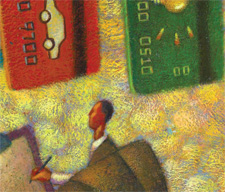
The Debt Zone
Smart Choices, Less Worry
By Riley Mackenzie
First, the good news:
You know that often-quoted figure that says the average American household carries $8,000 in credit card debt? It's a little misleading. According to the Federal Reserve, most Americans owe nothing to credit card companies, and of the households that do carry a balance, most owe less than $2,000. Only about one in 20 households is struggling with a stubborn balance of $8,000 or more.
Now that the holiday season is past and your mailbox has more bills than catalogs, that may be hard to believe. And that leads us to the bad news: For many Americans, debt is an increasingly virulent threat to their financial security. A perfect storm of retail temptation, economic optimism, aggressive marketing and just plain ignorance has swept many consumers into deep trouble. What seemed to promise the key to the good life has, paradoxically, become a major roadblock to financial security.

“Debt is definitely the scourge of our times. Basically, people just can’t wait long enough to save for a large purchase.”
Joseph Andrade ’87
Primerica Financial Services
"It's amazing how much debt we see out there,"says Joseph Andrade '87, a registered representative with Primerica Financial Services in Clarence, N.Y. "Debt is definitely the scourge of our times. Basically, people just can't wait long enough to save for a large purchase."
Good Debt, Bad Debt

Which is not to say that debt can't sometimes be useful. Many experts distinguish between "good debt" and "bad debt." The former, they say, is a tool; the latter is a burden.
Ayesha Nariman, MBA '91, a financial adviser with Ameriprise Financial in Williamsville, N.Y., says good debt is incurred to buy an asset that appreciates—mainly a home. "Most people in this country would not be able to purchase a home without taking a mortgage," she says. "Under normal conditions, home prices appreciate. Now, these are not normal times in the real estate market, but in general that is an asset that appreciates. Furthermore, with good debt, the asset outlives the debt.” A home loan, she adds, may come at a favorable rate because it’s securitized— the house serves as collateral. And home mortgage interest is tax-deductible, making it an even better bargain.

“With good debt, the asset outlives the debt.”
Ayesha Nariman, MBA ’91
Ameriprise Financial
After that, Nariman says, it gets trickier. An auto loan is a mixed bag in some ways— again the asset serves as collateral and the interest rates charged are lower than credit cards—but because a new car depreciates rapidly and one can’t write off the interest, it’s less desirable as a financial tool.
On the other hand, notes Guarav Patankar, MBA ’03, a global financial institutions’ analyst with SuNova Capital in New York City, if that car takes you to a $30-an-hour job, taking on an auto loan makes sense. “An educated borrower,” he says, “would make a good top-down and bottom-up assessment of where this opportunity could lead him. If it’s not an opportunity that deserves that kind of leverage, the person is digging himself into a hole.”

“An educated borrower would make a good topdown and bottom-up assessment of where this opportunity could lead him.”
Guarav Patankar, MBA ’03
SuNova Capital LP
Education loans, a reality for practically every student in these days of Cadillac college costs, fall under good debt, Nariman says, because “you expect an appreciation. Education is supposed to elevate you to a better lifestyle later on.”
But Martin Coulter ’78, a financial adviser with Northwestern Mutual Life of Williamsville, N.Y., adds a note of caution—not for students, but for parents considering how much debt to take on for college.
“Both parents and students want to see these kids get the best diploma they can,” Coulter says. “Often people are paying an awful lot to chase prestige where there might be more financially responsible answers,” such as two years at a community college, then a transfer to a four-year institution.

“Both parents and students want to see these kids get the best diploma they can. Often people are paying an awful lot to chase prestige.”
Martin D. Coulter ’78, CLU, ChFC
Northwestern Mutual Financial Network
He uses the example of parents shelling out $120,000 for a child’s education; “in 20 years, that money would be worth maybe $384,000. That future value is what won’t be there for their retirement. People seem willing to take on these debts without thinking through the consequences.”
Good debt, bad debt. By any definition, carrying a credit card balance is the wrong way to use debt. “The majority of debt that people take on in their 30s and 40s is a house,” says Anthony Pandolfi ’99, a financial adviser with Morgan Stanley in Williamsville, N.Y. “And that’s OK. The thing thatkills them is, in their 20s and early 30s, they’re usingtheir credit cards. They’re making minimum payments, and they never get out of that vicious cycle. They’re always playing catch-up. There is smart debt, but credit card debt is the killer. It’s a black hole.”
Curse of the credit cards
“Credit card debt is particularly vicious,”Andrade says, “because it’s designed to keep the family in debt. People don’t realize this, but it’s by design. People don’t understand the real cost of, say, a $3,000 credit card balance. If you’re going to pay the minimum payment, maybe two percent of the balance or $15 a month, whichever is greater, and the card is at 19.8 percent, it’s going to take you 39 years to pay that thing off. What bigscreen TV is worth that?”

“There is smart debt, but credit card debt is the killer. It’s a black hole..”
Anthony P. Pandolfi ’99, ChFC
Morgan Stanley
Joseph Sgroi ’64, owner of Sgroi Financial in West Seneca, N.Y., has an even more extreme example: “A guy came to me, his income was $130,000, so he made enough money, but he was just bad with money, and his wife was worse. He had $66,000 in charge card debt. I showed him that if he made minimum payments, 20 years down the road he was basically still going to owe it all. The balance would be maybe $61,000—and he would have paid about $1 million in interest over those 20 years. I asked him, ‘Do you want to burn a million bucks or do you want to get this cleared up?’ When I put it like that, they get the concept.”
Lewis Mandell, a professor of finance and managerial economics at the University at Buffalo School of Management, has written three books about credit cards. Debt is something of a crusade for him, to the point that he has chosen to be without any debt in his personal financial life.
“I’ve had mortgages and credit card debt, and I have bought cars using debt,” he says. “But I never felt comfortable doing it, and I always wanted to minimize the amount.

“If you have no debt and now you retire, it’s that much less you have to take out of your investments.”
Joseph Sgroi ’64, CLU,ChFC
Sgroi Financial LLC
“You can’t live without credit cards, but I try to not pay interest on the bills. That way I can take advantage of all the benefits credit cards offer, but without the costs.”
That, he says, makes him a pariah among credit card issuers—what they call a “despised free rider.” “If you just use your credit cards for convenience and always pay them off,” Mandell says, “they can make some money on you, but they’re not going to get rich. The most desirable customers are in a situation you absolutely don’t want to be in”—the “permanent revolvers” whose interest dollars pay for a lot of executive suites.
That said, Mandell is realistic about the wrestling many Americans do with credit card debt: “Maybe in December you go into debt and you just don’t have the money to pay it off in January. Fine, just try to pay it off in February. That’s going to provoke some interest, but that’s OK. The key is not to make it a permanent situation.”

A love-hate relationship
From shopping with plastic to overly ambitious mortgages, Americans carry on an uneasy affair with debt. Their borrowing decisions are rooted not only in crunching the numbers, but in the depths of their emotional lives.
“Americans are the most profligate people on Earth,” Mandell says. “What accounts for this fact? I think there are two factors at work. “First, most younger Americans have really never seen any hard times. Times just keep getting better for them, and they expect to do better in the future than they have in the past.
“And also, we live in a culture in which debt is not seen as having any negative connotations. Americans are incredulous that people would not want to have debt. Debt is so ingrained in our culture that they feel it’s a necessary part of living. You don’t see this as much for first-generation Americans, refugees from other countries; Asian people particularly tend to be very savings-minded. It’s a cultural attitude.”

“We live in a culture in which debt is not seen as having any negative connotations.”
Lewis Mandell
School of Management
Patankar agrees, but notes that much of the world is beginning to follow the Americans’ lead. That’s true, he said, in his native India: “I come from a country where credit was almost taboo. When I was a student, if you were to ask my grandparents or parents, they would say, ‘Never go into debt.’ Now the mindset has undergone a sea change.”
Paul Kieffer ’82, MBA ’84, an M&T Bank administrative vice president in Buffalo who manages the bank’s personal financial planning group, sees a generational shift. Those who experienced the Great Depression, or whose parents did, tend to be wary of debt, he says.
“You have to manage your savings, but you have to enjoy life as well,” he says. “I sometimes meet with people who are living on Social Security and half of their pension, and they’re saving the rest of the pension for a rainy day. Some of these people are in their 90s. What rainy day? And then we’ll figure up their assets, and with the house and everything it might come to $1.5 million. They get a smile on their face and say, ‘Great, now we can get rid of that ’72 El Camino.’”

“You have to manage your savings, but you have to enjoy life as well.”
Paul Kieffer ’82, MBA ’84
M&T Bank
But for the most part, the grandchildren of those Depression survivors have left that wariness behind. Kieffer sees, for example, “an individual who works hard all day long and comes home and says, ‘I want to reward myself; life is short.’ That’s when they’ll go out and buy the more expensive vehicle or the newest gadget.” Probably, he says, on credit. That comfort with debt stems in part, Coulter says, from the rise in home prices. “Younger people are so comfortable with debt,” he says. “Maybe because of the size of mortgages today, they’re comfortable with volumes of debt that their parents would never be comfortable with.”
A part of the plan
Advisers know that managing one’s emotional life—the hopes and dreams that financial planning can make a reality—is a key to fiscal success. And debt management, they say, is a crucial part of one’s overall financial plan.
How much house, for example, does one really need? “Young people want to live in the lifestyle in which they have been raised, through most of their work life,” Nariman says. “I see people moving into the largest house they can get a mortgage for, even if they can’t buy a lot of furnishings. Then they go out and buy everything on credit cards, a fancy dining room and living room, and that’s where they get into trouble.
“It used to be that when you were 25, you lived in a broken-down apartment. Now you want to compete with what your parents have when they are 55.” As well, Coulter says, the usual succession of life events is moving later. When most people married at 25, took out a 30-year mortgage and stayed put, the house was paid for before retirement. Now, he says, many are marrying at 35 and moving up to a second home at 40 or 45, because they’re starting families later in life. So that debt is with them well into old age. “The balance,” he says, “is, when do I want it? Do I want the big house now, or do I want to be able to pay off the mortgage and have financial security later on?”

““All the studies that I’ve done seem to show that there’s no easy solution. Kids in high school are not very interested. And it’s very hard to reach adults, because they don’t want to sit down in a classroom and learn. The whole notion of compound interest and the time value of money is not something you can get across to a person in 10 seconds..”
Lewis Mandell
School of Management
The challenge of entering retirement debt-free is worth taking on, Sgroi and others say. “If you have no debt and now you retire,” Sgroi says, “it’s that much less you have to take out of your investments, and it’s that much more they can grow in retirement. Someone who retires with a $1,000 mortgage payment, that’s $12,000 a year. He’s got to take $18,000 out of his 401(k) to cover that, with taxes. I’d rather have him debt-free before he retires, including his mortgage.”

A teachable moment
So will Americans ever make their peace with debt and learn to use it responsibly? Mandell isn’t so sure. “All the studies that I’ve done seem to show that there’s no easy solution,” he says. “Kids in high school are not very interested. And it’s very hard to reach adults, because they don’t want to sit down in a classroom and learn. The whole notion of compound interest and the time value of money is not something you can get across to a person in 10 seconds.”
A lot of that education happens around the family dinner table, or should. “One of the biggest challenges we have with our high-net-worth clients is helping them to know that they have a fiduciary responsibility to their children to teach them how to manage debt,” Kieffer says. “For many of our clients, the biggest challenge is, how do you instill a good strong work ethic in their children?”
And broaching the subject, Sgroi says, is the first step both for parents leading their children and financial planners working with clients. “Years ago,” he says, “nobody talked about money. That’s really the problem. People do whatever they think is right and end up getting into trouble. I think if families talked about money with their children, a lot of this would be taken care of.
“It’s just like going to the doctor. Certainly all you can do is teach people where they are going wrong and give them the road map to get out. What they do with that vital information you give them is their business.”

Five steps to taming your debt
Looking to make debt work for you rather than against you? The first thing to know is that it’s not about your income. “I see people who make $35,000 or $40,000 a year, and they’re debt-free. And I have people coming to me who make $200,000, and they are in debt. It’s their spending habits,” says Ayesha Nariman, MBA ’91, a financial adviser with Ameriprise Financial.
Herewith, five ways to make debt a servant rather than a master: 1. Game the system: If you carry credit card debt, watch your mail for zero percent credit card offers, Nariman says. Transfer high-interest balances to those new cards, and pay them off before the interest-free period expires.
2. Optimize your repayment plan: List all your credit cards from highest-interest to lowest. Pay the minimum on all balances except the most expensive; attack that aggressively until it disappears, then tackle the next-most-expensive. “You’ll start saving so much money, then when you knock one off, you have such a win,” says Joseph Sgroi ’64, owner of Sgroi Financial. “The first one is the toughest, and oftentimes it’s the largest, believe it or not. You would be amazed how much faster you can pay down your debt with this strategy.”
3. Keep in touch with your lender: “If you’re falling behind, it’s very important for people to call the credit card company or the bank and try to work out a deal,” Nariman says. “The bank doesn’t really want to have the home on their hands, the foreclosure. If you can’t pay the whole thing off, work out a partial payment. You can also say, ‘I’m getting these offers for 8 percent’ or whatever—‘what can you do with my card?’”
4. Remember that you’re spending real money: “One trick I use,” Sgroi says, “is, when I put a charge on a charge card, as soon as I get home I write a check for the full amount of the charge and I pencil-change my balance, even if it’s minus. Let’s say you charge $2,000 and you have only $1,000 in your checking account; now you’ve got minus-$1,000 in your checking account balance. If you have any sense of responsibility, that’ll drive you nuts.”
5. Think savings before lifestyle: “When they get a 10 percent raise, the majority of people tend to spend it and not save it,” says Anthony Pandolfi ’99, a financial adviser with Morgan Stanley. “When you get a raise, automatically bump your 401(k) contribution up a few percent. If you get a bonus or a big payout, do the same.”
